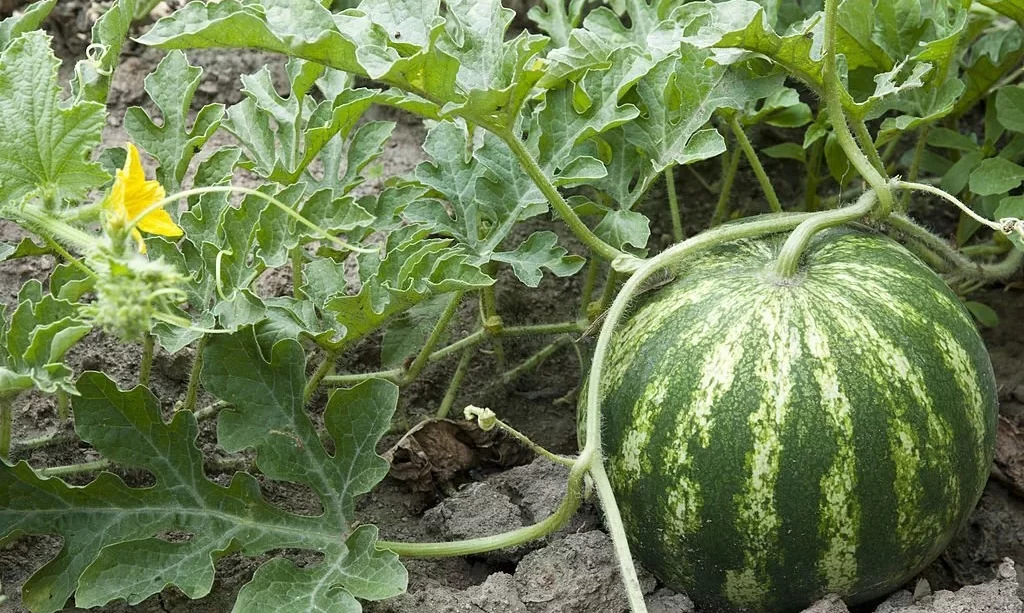The arrival of summer brings with it the promise of sun-soaked days and a favorite seasonal delight – the watermelon. This juicy, refreshing fruit, often synonymous with picnics and poolside gatherings, has a unique charm that transcends generations. Yet, hidden beneath its sprawling vines and vibrant green leaves lies a world that often remains unseen but is crucial to its growth – the root system.
In our quest to cultivate the perfect watermelon patch or appreciate the complexity of this beloved fruit, understanding the depth to which watermelon roots grow is a fundamental piece of knowledge. The roots serve as the anchor, the lifeline, and the source of nourishment for these sun-loving plants. In this exploration, we’ll delve into the fascinating world of watermelon roots, beginning with the anatomy of these vital underground structures.
- 🏅 TRUSTED VARIETY – Popular watermelon seeds used by gardeners for years. It produces beautiful smaller, round watermelons.
- 🍉 DELICIOUS – Although these watermelons are smaller, they pack big, sweet flavor. Very refreshing on a hot summer day.
- ☀️ HEAT LOVING – Watermelons love the heat and will thrive during the hot, summer months.
- 🇺🇸 USA – All of our seeds, including the sugar baby watermelon seeds for planting a home garden, are heirloom, open-pollinated and non-GMO, and grown in the USA. Don’t buy inferior seeds from other countries. This should give you added reassurance that not only can you enjoy the seeds this season, but you can save the seeds each year, adding food security to your home.
- ⚖️ PACKETS – Each sugar baby watermelon seed packet is printed on water-resistant paper, in full color, with growing and harvesting directions included. Each heirloom watermelon seeds packet contains at least 2 grams of seeds (approximately 45+ seeds).
Anatomy of Watermelon Roots
To truly grasp the intricacies of watermelon root growth, let’s start with a closer look at their anatomy:
- Primary Taproot: Watermelon plants typically begin life with a central taproot, a robust and thick structure that extends downward into the soil. This primary taproot serves as the anchor for the plant, firmly establishing it in the ground.
- Lateral Roots: As the watermelon plant matures, it produces lateral roots that branch out from the primary taproot. These lateral roots are responsible for the absorption of water and essential nutrients from the soil.
- Fibrous Network: The lateral roots give rise to a fibrous network of rootlets, which further increases the plant’s ability to explore and extract resources from the surrounding soil. This intricate network provides stability and sustenance.
The watermelon’s underground realm is a dynamic and essential part of its growth, ensuring that it remains firmly grounded and well-nourished. By understanding the anatomy of these roots, we gain insights into the plant’s resilience and its remarkable ability to produce the succulent, sweet fruit that graces our summer tables.
Root Development in Watermelon Plants
Root development in watermelon plants is a fascinating journey that begins with the germination of seeds and continues throughout the plant’s life cycle:
- Seed Germination: The journey of watermelon roots begins when a seed germinates. Initially, a small taproot emerges from the seed, seeking downward into the soil. This taproot’s early growth is vital for anchoring the plant.
- Early Seedling Stage: During the early stages of growth, watermelon seedlings primarily focus on developing their root system. As the taproot extends deeper into the soil, lateral roots begin to form, branching out horizontally.
- Maturation: As the watermelon plant matures, the root system becomes more intricate and robust. Lateral roots proliferate, forming a network that explores the soil in search of water and essential nutrients. This well-developed root system supports the plant’s growth and fruit production.
- Beautiful – Large individual packets of Red Jubilee, Yellow Petite and Orange Tendersweet Watermelons; Grow an abundant harvest of sweet watermelon in a variety of colors. Minimum of 2g per packet.
- Productive – Watermelons love heat, the hotter the better. If you live in a cooler climate, start seeds indoors early and transplant to the hottest spot in your yard.
- Sweet – True to their name, the flesh of these giant watermelons is sweet and refreshing. Each color tastes slightly different.
- Easy to Grow – Instructions included on each packet. Plus, we are available to answer all your questions. If these seeds don’t germinate, we will happily make it right for you.
- Safe and Sustainable – Our operation is fully solar powered, and Sow Right Seeds has taken the Safe Seed Pledge to sell only fresh Non-GMO heirloom seeds for you and your family.
Depth of Watermelon Roots
Now, let’s address the critical question of how deep watermelon roots tend to grow:
- Shallow Rooted: Watermelon roots typically remain relatively shallow compared to some other crops. The bulk of the root system is concentrated in the top 12 to 18 inches of soil. While some roots may extend deeper, the majority of watermelon’s nutrient absorption and water uptake occurs in this upper layer of the soil.
- Wide Spread: Although the roots primarily grow near the surface, they can spread widely, covering a substantial area around the base of the plant. This extensive lateral spread allows the plant to explore a larger volume of soil for resources.
Factors Influencing Root Depth
Several factors can influence the depth to which watermelon roots grow:
- Soil Type: The type and quality of the soil play a significant role. Sandy soils may encourage deeper root growth, while heavy clay soils can restrict it. Well-draining, loamy soils tend to promote healthy root development.
- Environmental Conditions: Factors such as temperature, moisture levels, and the availability of nutrients in the soil can influence root depth. Adequate moisture in the topsoil is crucial for encouraging lateral root growth.
- Cultural Practices: Proper soil preparation, watering practices, and fertilization can all impact root development. Adequate spacing between watermelon plants allows for healthier root systems to develop.
Understanding these factors and their impact on watermelon root growth can help gardeners and growers provide optimal conditions for their watermelon plants. By nurturing healthy root systems, one can ensure robust vines and an abundance of sweet, juicy watermelons come harvest time.
Benefits of Understanding Watermelon Root Depth
Understanding the depth to which watermelon roots grow offers a range of benefits for both home gardeners and commercial growers:
- Efficient Irrigation: Knowledge of the root system’s depth enables more precise and efficient irrigation. Gardeners can focus their watering efforts on the upper soil layers where the majority of the roots are, reducing water wastage.
- Optimal Nutrient Delivery: Properly managed watering and fertilization can ensure that essential nutrients reach the root zone where they are most needed. This knowledge prevents over-fertilization and supports healthy root development.
- Preventing Root Stress: Avoiding excessive watering or shallow watering practices can prevent root stress, which can lead to issues like root rot. Healthy roots contribute to the overall vigor and productivity of watermelon plants.
- Resource Conservation: By tailoring watering practices to the root depth, gardeners and growers can conserve precious water resources, which is especially vital in regions with water scarcity.
- Hand-crafted, micro-brewed liquid fertilizer for all vegetables. 4.5-2.5-6.0 NPK.
- Super-concentrated: 256:1. One quart gallon makes 64 gallons of full-strength fertilizer.
- 100% complete, 100% water soluble, precision formulated and blended.
- Made from organic components, mycorrhizae, humic acid, kelp, enzymes, and minerals.
- Calcium rich! No more blossom-end rot.
Practical Tips for Watering Watermelon Plants
To make the most of your understanding of watermelon root depth, consider the following practical tips for watering watermelon plants:
- Use Drip Irrigation: Drip irrigation systems deliver water directly to the base of the plants, minimizing water loss and promoting deep root penetration.
- Water at Ground Level: When hand watering, avoid wetting the foliage and focus on the soil around the base of the plant to prevent the development of fungal diseases.
- Mulch Application: Apply mulch around your watermelon plants to retain soil moisture, regulate soil temperature, and reduce weed competition, all of which support healthy root growth.
- Monitor Soil Moisture: Regularly check soil moisture levels in the top 12 to 18 inches of soil. Water when the soil begins to dry out within this depth.
- Avoid Overwatering: Ensure that the soil drains well and avoid overwatering, as waterlogged soil can harm the roots. Proper drainage is essential.
Conclusion
In the world of watermelons, understanding the depth to which their roots grow is akin to unlocking the secret to their successful cultivation. Armed with this knowledge, gardeners and growers can fine-tune their practices to ensure optimal conditions for watermelon plants.
Efficient irrigation, targeted nutrient delivery, root stress prevention, and resource conservation are some of the rewards of this understanding. By implementing practical tips for watering and nurturing healthy root systems, you not only enhance the growth and yield of your watermelon crop but also contribute to the overall sustainability of your garden or farm.
As you embark on your watermelon-growing journey, remember that beneath the juicy, delicious fruits lies a hidden world of roots, a testament to the plant’s resilience and the gardener’s dedication. May your watermelon patch flourish, yielding the sweetest rewards of summer.






